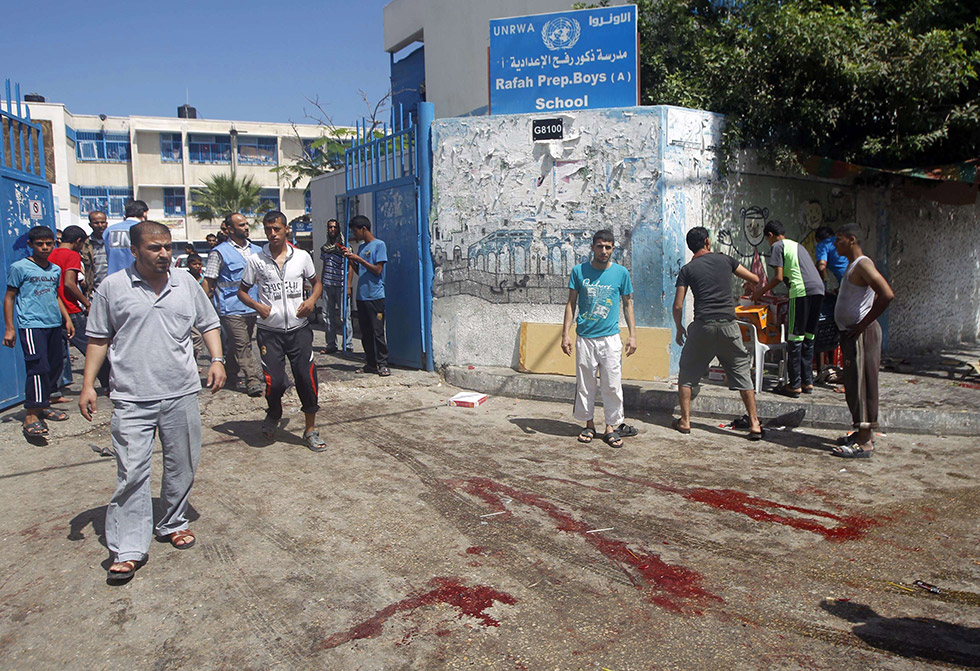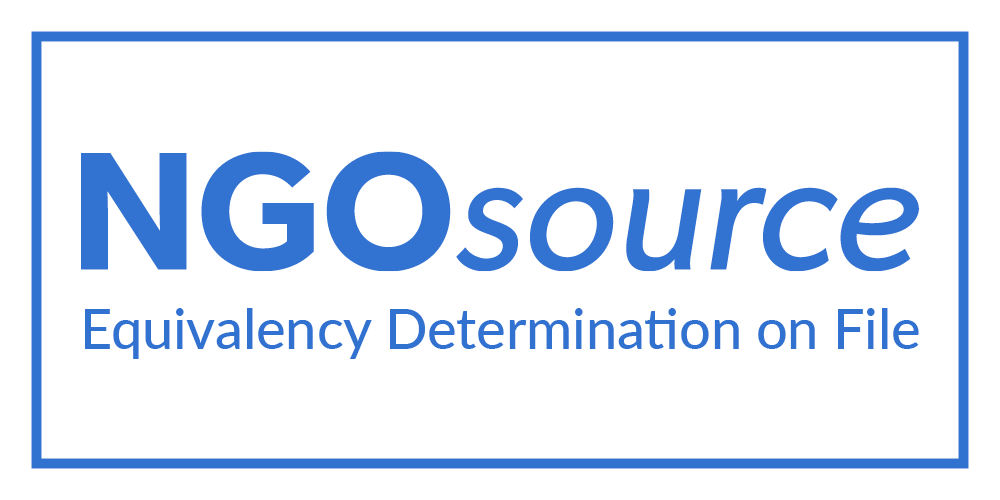Israeli military refuses to investigate attack near UNRWA School in Rafah, Gaza that killed 14 civilians
Adalah – The Legal Center for Arab Minority Rights in Israel and Al Mezan Center for Human Rights in Gaza responded on 31 August 2016 to the Israeli military's decision - made public on 24 August 2016 - to close the file without opening a criminal investigation in one of the United Nations Relief and Works Agency (UNRWA) school cases.
The case involves a drone missile attack at the entrance of the UNRWA school in Rafah during the 2014 military offensive in Gaza that killed two people on a motorbike, the targets of the shelling, and 12 other Palestinian civilians near the school.
The two human rights organizations sharply contest the MAG’s decision, which demonstrates impunity masquerading as due process. Two years after the attack, an independent, robust and, credible investigation, compliant with the relevant international standards is still awaited.

The scene following an Israeli drone missile attack at the entrance of the UNRWA school in Rafah during the 2014 military offensive in Gaza that killed two people on a motorbike, the targets of the shelling, and 12 other Palestinian civilians near the school. (Photo courtesy of Said Khatib/Stringer)
On 24 August 2016, the Israeli Military Advocate General (MAG) announced on its website updates in relation to this case and a number of other incidents that occurred during Operation 'Protective Edge' (OPE) without opening any criminal investigations.
According to substantial investigations undertaken by Al Mezan in Gaza, the 3 August 2014 Israeli missile strike at the entrance of the UNRWA school in Rafah killed 14 people, including eight children, and wounded at least 25 others. About 3,000 people were taking shelter in the school at the time of the Israeli strike. UNRWA has stated that it informed the Israeli military authorities on 33 separate occasions that the Rafah school was being used to accommodate displaced civilians, the last such occasion only one hour before the attack. (See Background Information below for further details).
With reasonable cause to believe the attack violated international humanitarian law (IHL), human rights law and criminal law, Adalah and Al Mezan filed a complaint on 31 August 2014 to the MAG and Attorney General (AG) demanding they initiate an independent criminal investigation into the case, and four other cases concerning attacks on UNRWA schools, and to prosecute and hold to account those found to be responsible. On 25 February 2015, Al Mezan provided additional documentation to the MAG specifically about the attack on this school and its victims.
Over the last two years, however, the only response the human rights organizations received from the MAG came in November 2015, claiming that the case was still under examination. The MAG made no requests of the organizations for further information, photographic evidence, or for the clarification of documented testimony. Reminder letters were sent in February and June 2016, again asking for an update on the status of the case to no avail.
What the MAG disclosed in its 24 August 2016 Update #5 is essentially the same information that was cited in the UN Commission of Inquiry report of June 2015: "[T[he Government of Israel told the United Nations Board of Inquiry that 'the IDF had fired an aerial-launched missile at the motorcycle, which had been carrying three militants from Palestinian Islamic Jihad. By the time it became apparent that the strike would coincide with the motorcycle passing by the school gate, it had no longer been possible to divert the missile.” (para. 443) Notably, while the MAG also confirmed in its Update #5 that it was aware of the presence of civilians in the school, 14 months later it made the same assertions focusing on the targets, timing, and ammunition, and concluding that there was nothing wrong with any of these decisions, and that lessons had been learned.
In response to the MAG’s findings, Adalah and Al Mezan further assert the following:
1) Civilians not combatants. Based on Al Mezan’s investigations, the two persons (and not three as claimed by the MAG) who were riding on the motorcycle were civilians and not combatants, as alleged by the Israeli military. One of them was 17-years old. Therefore, and in the initial analysis, targeting the people on the motorcycle is a prohibited attack on a civilian target;
2) Violation of the principles of distinction and proportionality. As the MAG admitted, the Israeli military authorities were aware of the fact that the school was being used as a shelter for civilians, as UNRWA has confirmed. The decision to fire a missile at a target, whether legitimate or not, in this location reflects a total disregard of the basic IHL principles of distinction and proportionality;
3) Danger of selected ammunition. Given the above, if it was not technically possible, as the Israeli authorities assert, to divert the high precision missile in question, it was clearly negligent to use this ammunition in the vicinity of the school/shelter. The UN Commission of Inquiry (COI) also found that imprecise weapons were used, concluding that the attack is "highly likely to constitute an indiscriminate attack which, depending on the circumstances, may qualify as a direct attack against civilians, and may therefore amount to a war crime." (para. 446)
4) No recognition of command responsibility. The MAG’s Update #5 does not discuss issues of command responsibility, although the decision was made at high levels to use the particular munitions in the area of a school/shelter, and despite MAG’s acknowledgement that the school was sheltering a high number of civilians;
5) No remedy for victims. The MAG's claim that the result was “an honest mistake” diminishes the severe outcome: recognition that a dozen civilians were killed while sheltering in a UN facility. It takes no responsibility for the killings and it offers victims no path for justice or reparation. UNRWA also objected to the MAG’s closure of the case without conducting an investigation and without redress for victims, in its response dated 26 August 2016:
"We remain determined to ensure that incidents are thoroughly investigated," UNRWA said. "We have called for accountability in this case and in others that took place during the 2014 war. Any indication that responsibility was being evaded would be a matter of grave concern… We note that no criminal responsibility seems to be accepted for any concluded cases concerning UNRWA premises. The families affected have had no effective redress and, from their perspective, this would certainly be seen as a further denial of their rights."
Al Mezan and Adalah conclude that, “This case shows that the Israeli investigation system is deeply flawed and contradicts international law and norms of investigation. The MAG's decision not to investigate, made public two years after the attack, demonstrates entrenched impunity and the need for an independent, thorough, transparent and credible investigation. The international community must recognize and ensure the rights of victims to justice and reparation.”
READ: Joint Adalah-Al Mezan report : Gaza 2 Years On, Impunity over Accountability
READ: Adalah's Work on 2014 Gaza War Complaints (Updated August 2016)
READ: Adalah’s Letter from August 2014 (Hebrew)
Background information:
On 31 July 2014, at the peak of Operation Protective Edge (OPE), it was announced that all parties had agreed to an unconditional humanitarian ceasefire in Gaza, to commence at 8 am local time on Friday, 1 August 2014. The ceasefire was to last for a period of 72 hours subject to possible extension. During this time, the Israeli forces on the ground remained in place in Rafah, penetrating deeper into city, leading to clashes with Palestinian fighters.
Within 30 minutes of the ostensible ceasefire, tank and/or artillery shelling resumed. The shelling intensified following the reported invocation of the Hannibal Directive. At this time, the Israeli army unleashed a barrage of attacks directed against the civilian population in Rafah. Very intensive shelling of the eastern parts of Rafah ensued, hitting houses and people as they tried to flee from the area. Close to 2,000 missiles, bombs, and shells were fired on Rafah that morning, with tank and artillery shelling, fighter-jets and fighter helicopters attacks, and 260 mortar shells fired on the town.[1] The attacks and restrictions on movement continued for four days, with dozens of airstrikes targeting inhabited houses, killing scores of people, ambulances, schools and vehicles. Many of these strikes were launched by drones, and led to the killing of civilians.
On 3 August 2014, the Israeli military conducted a drone attack in the proximity of an UNRWA school in Rafah. At approximately 10.35 am, a drone missile was fired at two people riding on a motorcycle as they passed the entrance to UNRWA School ‘A’, which was being used as a shelter for internally displaced persons (IDPs). The two people on the motorcycle were killed, together with 12 others who were in the vicinity of the school entrance. The testimonies and other evidence collected by Al Mezan for months after the attack indicates that all the victims were civilians, including the two persons who were on the motorcycle. The following list provides the names and ages of the victims:
On the motorcycle:
1. Ahmad Kamal Abed Al Nahal, aged 25, and
2. Ismail Samir Suleiman Shalouf, aged 17.
People killed by the entrance of the school:
1. Aya Mohammed Ghanem Abu Rijel, IDP, aged 4;
2. Munther Mohammed Ghanem Abu Rijel, IDP, aged 6;
3. Saqer Bassam Suleiman Al Kashef, IDP, aged 7;
4. Tareq Ziad Suleiman Abu Khatleh, IDP, aged 9;
5. ‘Amr Tareq Sa‘id Abu Al Rous, IDP, aged 16;
6. Hazem Abdel Al Basset Abdel Fatah Abu Helal, aged 25, a part-time guard at the school;
7. Ahmed Khaled Ali Abu Harba, aged 14, street seller;
8. Yousef Akram Saleh Al Iskafi, aged 16, street seller;
9. ‘Izz Al Din Walid Mohammed Abu Sneimeh, IDP, aged 12, died on 9 August 2014;
10. Nadia Fawzi Hussein Abu Hamad (W), IDP, aged 26, died on 7 August 2014;
11. Jamal Abdel Rahman Hamza Abu Libda, aged 50, from Khan Younis, died on 11 October 2014; and
12. Madhat Fayez Mohammed Ghayyad, aged 31, died on 7 February 2015.
[1] Zitun, IDF's Gaza probe reveals Hamas outsmarted forces in Rafah (14 April 2015), YNet News, available at: http://www.ynetnews.com/articles/0,7340,L-4647096,00.html (accessed 9 February 2016).












